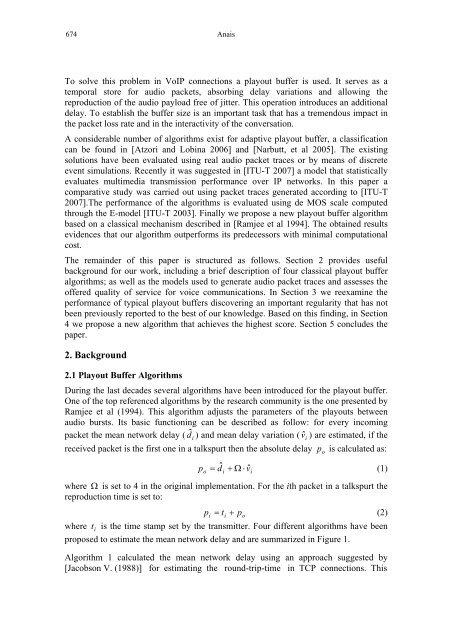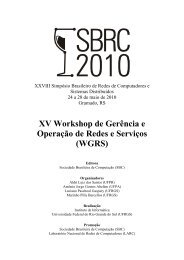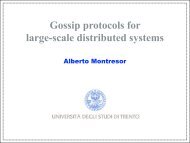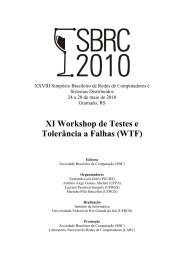Classical Playout Buffer Algorithm Revisited
Classical Playout Buffer Algorithm Revisited
Classical Playout Buffer Algorithm Revisited
You also want an ePaper? Increase the reach of your titles
YUMPU automatically turns print PDFs into web optimized ePapers that Google loves.
674 Anais<br />
To solve this problem in VoIP connections a playout buffer is used. It serves as a<br />
temporal store for audio packets, absorbing delay variations and allowing the<br />
reproduction of the audio payload free of jitter. This operation introduces an additional<br />
delay. To establish the buffer size is an important task that has a tremendous impact in<br />
the packet loss rate and in the interactivity of the conversation.<br />
A considerable number of algorithms exist for adaptive playout buffer, a classification<br />
can be found in [Atzori and Lobina 2006] and [Narbutt, et al 2005]. The existing<br />
solutions have been evaluated using real audio packet traces or by means of discrete<br />
event simulations. Recently it was suggested in [ITU-T 2007] a model that statistically<br />
evaluates multimedia transmission performance over IP networks. In this paper a<br />
comparative study was carried out using packet traces generated according to [ITU-T<br />
2007].The performance of the algorithms is evaluated using de MOS scale computed<br />
through the E-model [ITU-T 2003]. Finally we propose a new playout buffer algorithm<br />
based on a classical mechanism described in [Ramjee et al 1994]. The obtained results<br />
evidences that our algorithm outperforms its predecessors with minimal computational<br />
cost.<br />
The remainder of this paper is structured as follows. Section 2 provides useful<br />
background for our work, including a brief description of four classical playout buffer<br />
algorithms; as well as the models used to generate audio packet traces and assesses the<br />
offered quality of service for voice communications. In Section 3 we reexamine the<br />
performance of typical playout buffers discovering an important regularity that has not<br />
been previously reported to the best of our knowledge. Based on this finding, in Section<br />
4 we propose a new algorithm that achieves the highest score. Section 5 concludes the<br />
paper.<br />
2. Background<br />
2.1 <strong>Playout</strong> <strong>Buffer</strong> <strong>Algorithm</strong>s<br />
During the last decades several algorithms have been introduced for the playout buffer.<br />
One of the top referenced algorithms by the research community is the one presented by<br />
Ramjee et al (1994). This algorithm adjusts the parameters of the playouts between<br />
audio bursts. Its basic functioning can be described as follow: for every incoming<br />
packet the mean network delay ( dˆ i ) and mean delay variation ( vˆ i ) are estimated, if the<br />
received packet is the first one in a talkspurt then the absolute delay p o is calculated as:<br />
p<br />
o<br />
= dˆ<br />
+ Ω ⋅ vˆ<br />
(1)<br />
i<br />
where Ω is set to 4 in the original implementation. For the ith packet in a talkspurt the<br />
reproduction time is set to:<br />
p i = ti<br />
+ po<br />
(2)<br />
where t i is the time stamp set by the transmitter. Four different algorithms have been<br />
proposed to estimate the mean network delay and are summarized in Figure 1.<br />
<strong>Algorithm</strong> 1 calculated the mean network delay using an approach suggested by<br />
[Jacobson V. (1988)] for estimating the round-trip-time in TCP connections. This<br />
i







